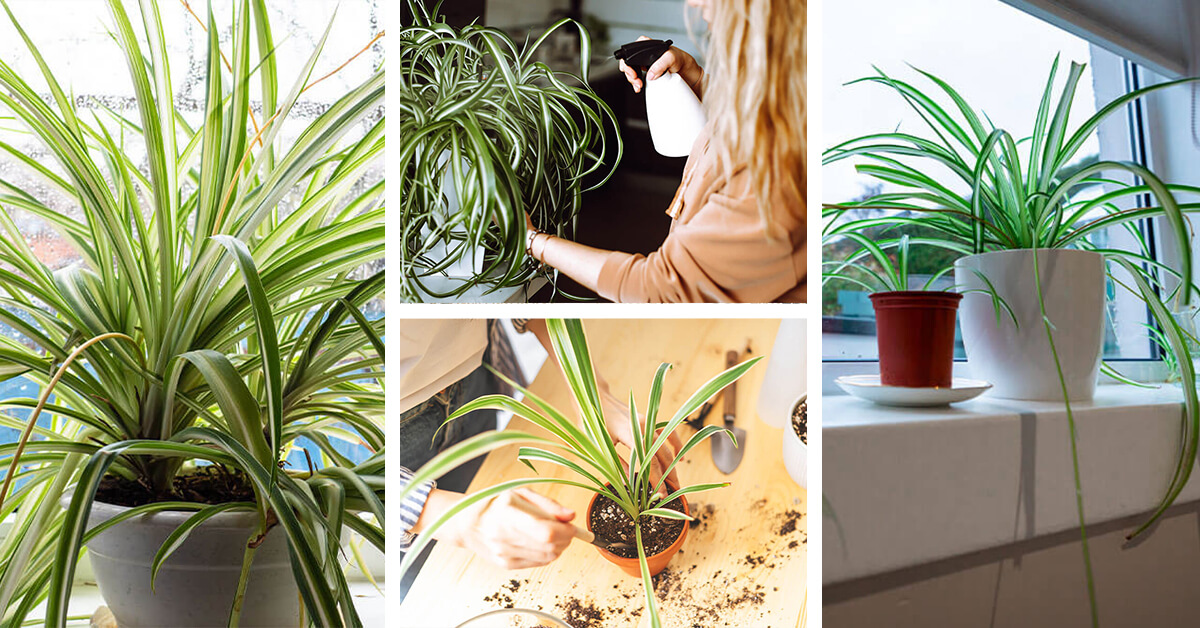Are you a beginner gardener? If so, you’re in for a treat with spider plant care. Its long, narrow leaves grow in a rosette pattern. They gracefully drape over the pot’s edge like a green skirt. Spider plants produce little plantlets, so you can grow more of them any time you want!
Key Takeaways
- Spider plants are an excellent choice for a beginner gardener.
- With spider plants, think “moderate” – light, temperature, and moisture.
- Brown leaves on your spider plant do not mean it’s dying. There are various potential problems that you can remedy easily.
What is spider plant?
Think about this: an easy-to-grow plant that tolerates all light levels and won’t die if you miss watering it for a week. That sums up the spider plant perfectly. You can grow them in containers or hanging plots in USDA Hardiness Zones 9-11.
Some people use spider plants in their gardens out of direct sun. However, they prefer being indoors with consistent warm temperatures. One frost kills this tropical plant (native to Africa).
You can put spider plants on display in hanging baskets. This means they don’t take up room in smaller spaces, perfect for apartment dwellers. The Victorians, in particular, loved spider plants and suspended them all over the household.
By the way, you might not think about blossoms on spider plants, but they come forward in the summer. The flowers are tiny and white, balanced on long stems as if showing off.
Shopping for Spider Plants
Before even considering what variety of spider plants you want, you’ll need just a little information when you shop for one. There is nothing more disappointing than bringing home a plant and watching it dye in a few weeks.
So, when you are at the garden center, survey a plant that appeals to you. Look closely for any sign of pests. Avoid plants that have yellow leaves (unless it’s a cultivar with yellow variegation).
Make sure the plant has no browning. You want a full, bushy plant with vivid green leaves. And while the larger plants might be tempting, always buy the right size for your needs. Envision the space you have and go from there. Remember, these are fast growers.
Spider Plants as Vegetables? When you look at a hanging spider plant, you would not think that it had anything to do with vegetables. In truth, C. comosum has a cousin: Asparagus! Other relatives in the family include monkey grass, hosta, yucca, and agave.
Spider Plant Types
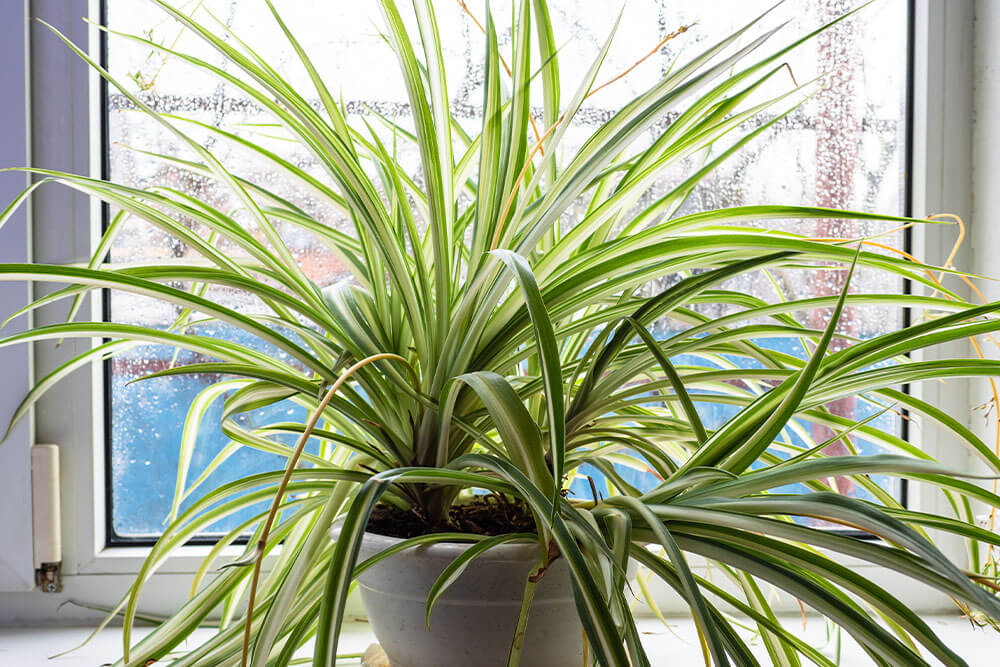
Spider plants have other names by which they’re called, including spider ivy, ribbon plant, and airplane plant, all of which seem apt. And you have a fine selection for consideration when you’re shopping.
- Airplane Spider Plant: This cultivar has the traditional cream stripe in the center. However, the edges of the plant are very dark green to the point of looking black.
- Green Orange: This spider plant has spiky-shaped plants. The orange leaf stem and vein are very noticeable in sunlight.
- Mandaianum: A dwarf spider plant, great for tight spaces. The leaves won’t grow beyond six inches, bearing a bright yellow stripe against dazzling green.
- Milky Way: The center of each leaf has a large creamy white band. It’s a brighter plant than some other cultivars, showing off in the light beautifully. It has yellowish or cream flower stalks.
- Picturatum Spider Plant: The name gives much away about this plant. It’s among the most colorful you’ll find, with highly showy foliage. Creamy stripes lie on a field of bright green. A nice choice for a hanging basket.
- Ocean: A relatively new cultivar with streaked green leaf margins and a white stripe from the bottom to the tip. Leaves grow no more than 12 inches, but they’re broad.
- Variegated Bonnie: Striped, curled leaves, the center is creamy white.
- Variegatum (Variegated Spider Plant): Instead of a stripe down the middle, variegatum has white edging on each leaf.
- Vittatum: The leaves are dark green with a white stripe right down the middle of each leaf. Sometimes the stripe appears as a band, and in others, it nearly goes to the edge of the leaf. This is a large plant with leaves that can grow up to 16 inches.
- Zebra: The narrow leaves and slim white center give the Zebra Spider plant an exotic feel. This configuration looks similar to the stripes on a Zebra. Fast Grower.
In Asian cultures, spider plants are “good fortune” plants. They represent health, too. Their sturdy vines typify stability. In India, it signifies positive energy and providence. Hang them in your bedroom for fertility.
Growing Spider Plants Successfully
There’s a reason you often see spider plants as bathroom decorations. They thrive on humidity and warmth. In other parts of the house, they appreciate hanging high (heat rises). If you decide to place the plant on a shelf, keep an eye on it. As they grow, they become more heavy and may topple off.
Begin with a soil-based potting mix with good drainage. Spider plants don’t like being too wet. Offer fertilizer once or twice in spring and summer. Once planted, make sure your spider plant receives a moderate amount of sunlight. Direct sun can burn their leaves. If you take them outdoors in warmer months for embellishment, keep this in mind. Also, if you know the temperatures might drop below 55 °F, bring your plants back inside.
Baby spider plants take about a year to mature. Water them (wait for it) moderately. You want moist soil, not wet or dry. Once a week is usually fine. If you have high fluoride in your water, use filtered or distilled water. They’re sensitive to fluoride.
A Medicinal Food Plant: Studies indicate that the edible portions of spider plants have high levels of vitamins C and E. According to the “Journal of Medicinal Food Plants (2009) the plant’s tubers are an excellent source of fiber, zinc, protein, and potassium.
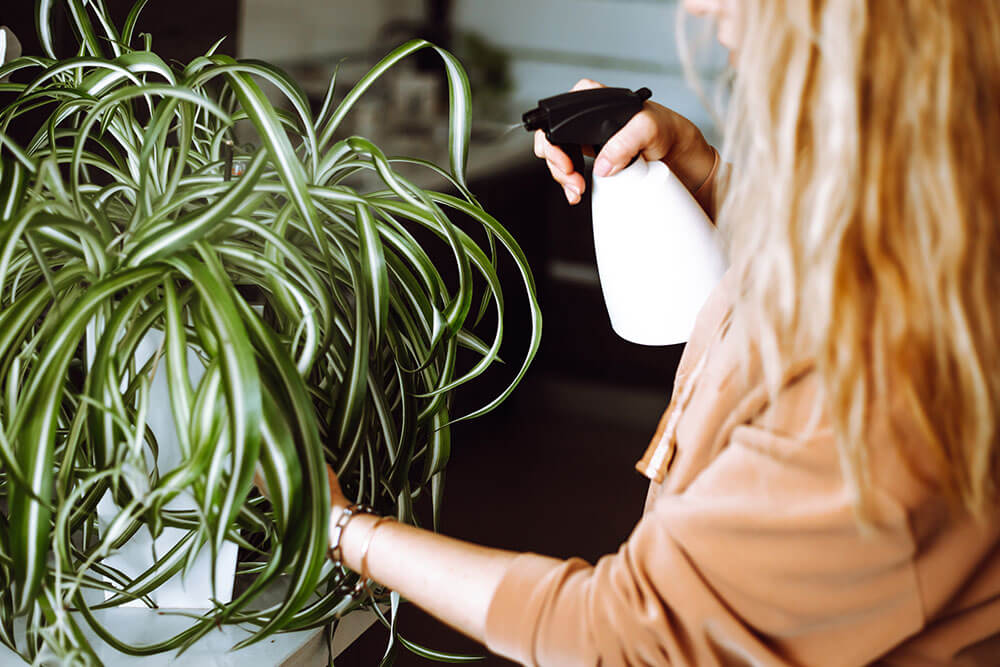
Repotting Spider Plants
If you already grow spider plants, you know they mature quickly, meaning they become cramped in their pot. If you’re not sure if it’s time yet, there are signs from the plant that you should repot.
Signs it’s Time to Repot your Spider Plant
- You notice the planter’s cracked. This happens because of the roots pushing outward.
- The plant seems thirsty all the time, with droopy leaves if you don’t water it.
- The roots of the plant begin peeking above the soil level.
- Roots may try to escape drainage holes, too.
When you see any of these, your plant needs more space. However, repotting in spring is best (the growing season).
You should repot the average run-of-the-mill spider plant every 1-2 years. They’re ok being rootbound for a while, but fast growth means planning ahead with larger planters on hand.
When repotting, move the whole plant into a prepared container. Loosen the roots a bit. If you want more plants, you can separate clumping matter on the plant, moving those cuttings into small planters. If you want, use the crock from which you just moved the mother plant.
Proper Potting
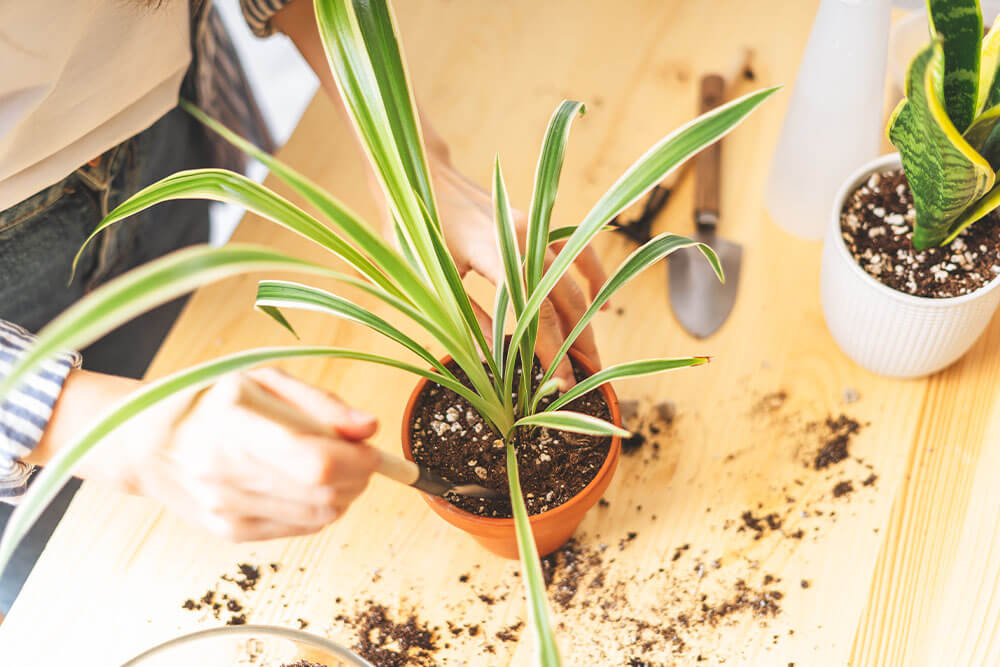
Measure the current pot, looking for the neck width. Buy a new container about 1 inch larger than that. Spider plants aren’t overly picky about their new home, so long as it has great water drainage. A standard nursery pot does the trick initially. Then, slide it into something more decorative.
Use standard potting soil for your plant. If you can get some perlite, it improves the health of the plant. Watch to make sure there is no puddling on top of the soil. That means too much water, and it can lead to root rot.
The Spider Plant Baby Boom
Spider plants are among the easiest to propagate. The mother plant produces little plants at the ends of the shoots. When those babies are about 2 inches, gently cut them off the web using sterilized scissors.
Transfer the cuttings into a container of water. YOu want just the ends submerged. Leaves remain dry. When you have inch-long roots, sow it as you would any spider plant.
Unlike some houseplants, spider plants are perfectly safe for your fur babies.
Spider Plant Pests and Diseases
Spider plants aren’t overly prone to pests and diseases. However, there are a few for which you can watch. Mealybugs are at the top of the list, being the most common insect affecting indoor plants. If you see white, fluffy residue, looking somewhat like cotton, on your spider plant’s stems, that’s mealybugs at work. SIt down with a paper towel and rubbing alcohol and wipe them off the plant. Pay particular attention to the leave’s base.
Spider mites leave distinctive residue, too. The leaves have yellow spots and you see web-like construction in the plant. Treat them with Neem oil or rubbing alcohol.
Then there’s scale. When you look at your plant, it appears as if there’s dirt on it, and the leaves are yellowing. Scales are little brown bumps. Neem oil is the easiest treatment.
In terms of disease, root rot is number one, usually caused by over-watering and insufficient drainage. Then, fungi and bacteria make themselves at home in the soil. Try switching out the potting soil completely (giving the container a good wash first). Time off any obviously dead roots and then settle them back into the soil.
“A beautiful plant is like having a friend around the house.” – Beth Ditto
Spider Plants in Feng Shui
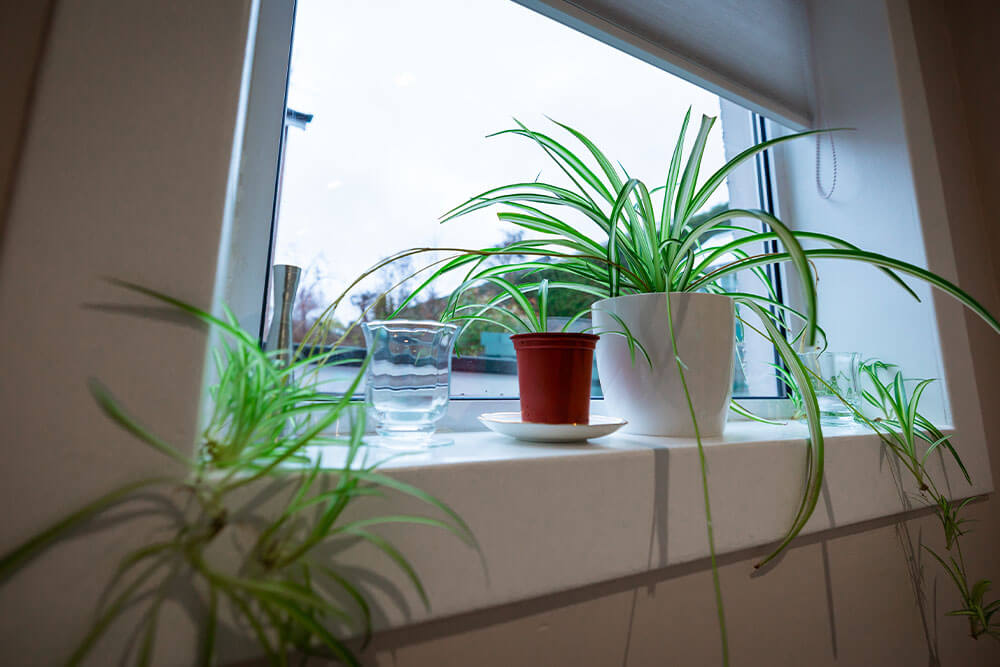
Feng Shui is the art of placement. It’s an ancient practice aimed at creating harmony, health, joy, and balance. When you arrange your space with intent, you open the path for positive Qi (life force). Plants can help.
Bringing the spider plant into your home also welcomes luck. Hang the plant in an area of your home that represents where you want that serendipity directed. Give a spider plant to a student for growth and reduced negativity.
Put your spider plant in the southeast portion of your home for health and prosperity.
Summary
A simple yet sublime bit of greenery, the spider plant is perfect for newer gardeners thanks to its forgiving nature. It’s not only easy to grow them indoors, spider plants prefer it. Most cannot withstand severe temperature changes. You can put it in nearly any space with indirect sunlight. It’s fine on a table but more suited to hanging from above.
[wp-faq-schema title=”Frequently Asked Questions About Spider Plant Care” accordion=1]
